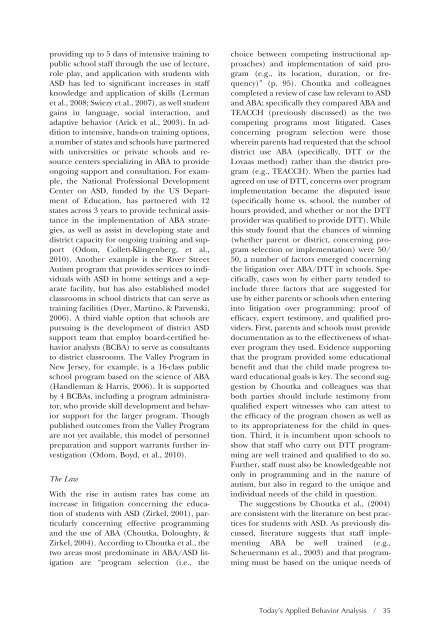Beyond Time Out and Table Time - Division on Autism and ...
Beyond Time Out and Table Time - Division on Autism and ...
Beyond Time Out and Table Time - Division on Autism and ...
Create successful ePaper yourself
Turn your PDF publications into a flip-book with our unique Google optimized e-Paper software.
providing up to 5 days of intensive training to<br />
public school staff through the use of lecture,<br />
role play, <str<strong>on</strong>g>and</str<strong>on</strong>g> applicati<strong>on</strong> with students with<br />
ASD has led to significant increases in staff<br />
knowledge <str<strong>on</strong>g>and</str<strong>on</strong>g> applicati<strong>on</strong> of skills (Lerman<br />
et al., 2008; Swiezy et al., 2007), as well student<br />
gains in language, social interacti<strong>on</strong>, <str<strong>on</strong>g>and</str<strong>on</strong>g><br />
adaptive behavior (Arick et al., 2003). In additi<strong>on</strong><br />
to intensive, h<str<strong>on</strong>g>and</str<strong>on</strong>g>s-<strong>on</strong> training opti<strong>on</strong>s,<br />
a number of states <str<strong>on</strong>g>and</str<strong>on</strong>g> schools have partnered<br />
with universities or private schools <str<strong>on</strong>g>and</str<strong>on</strong>g> resource<br />
centers specializing in ABA to provide<br />
<strong>on</strong>going support <str<strong>on</strong>g>and</str<strong>on</strong>g> c<strong>on</strong>sultati<strong>on</strong>. For example,<br />
the Nati<strong>on</strong>al Professi<strong>on</strong>al Development<br />
Center <strong>on</strong> ASD, funded by the US Department<br />
of Educati<strong>on</strong>, has partnered with 12<br />
states across 3 years to provide technical assistance<br />
in the implementati<strong>on</strong> of ABA strategies,<br />
as well as assist in developing state <str<strong>on</strong>g>and</str<strong>on</strong>g><br />
district capacity for <strong>on</strong>going training <str<strong>on</strong>g>and</str<strong>on</strong>g> support<br />
(Odom, Collett-Klingenberg, et al.,<br />
2010). Another example is the River Street<br />
<strong>Autism</strong> program that provides services to individuals<br />
with ASD in home settings <str<strong>on</strong>g>and</str<strong>on</strong>g> a separate<br />
facility, but has also established model<br />
classrooms in school districts that can serve as<br />
training facilities (Dyer, Martino, & Parvenski,<br />
2006). A third viable opti<strong>on</strong> that schools are<br />
pursuing is the development of district ASD<br />
support team that employ board-certified behavior<br />
analysts (BCBA) to serve as c<strong>on</strong>sultants<br />
to district classrooms. The Valley Program in<br />
New Jersey, for example, is a 16-class public<br />
school program based <strong>on</strong> the science of ABA<br />
(H<str<strong>on</strong>g>and</str<strong>on</strong>g>leman & Harris, 2006). It is supported<br />
by 4 BCBAs, including a program administrator,<br />
who provide skill development <str<strong>on</strong>g>and</str<strong>on</strong>g> behavior<br />
support for the larger program. Though<br />
published outcomes from the Valley Program<br />
are not yet available, this model of pers<strong>on</strong>nel<br />
preparati<strong>on</strong> <str<strong>on</strong>g>and</str<strong>on</strong>g> support warrants further investigati<strong>on</strong><br />
(Odom, Boyd, et al., 2010).<br />
The Law<br />
With the rise in autism rates has come an<br />
increase in litigati<strong>on</strong> c<strong>on</strong>cerning the educati<strong>on</strong><br />
of students with ASD (Zirkel, 2001), particularly<br />
c<strong>on</strong>cerning effective programming<br />
<str<strong>on</strong>g>and</str<strong>on</strong>g> the use of ABA (Choutka, Doloughty, &<br />
Zirkel, 2004). According to Choutka et al., the<br />
two areas most predominate in ABA/ASD litigati<strong>on</strong><br />
are “program selecti<strong>on</strong> (i.e., the<br />
choice between competing instructi<strong>on</strong>al approaches)<br />
<str<strong>on</strong>g>and</str<strong>on</strong>g> implementati<strong>on</strong> of said program<br />
(e.g., its locati<strong>on</strong>, durati<strong>on</strong>, or frequency)”<br />
(p. 95). Choutka <str<strong>on</strong>g>and</str<strong>on</strong>g> colleagues<br />
completed a review of case law relevant to ASD<br />
<str<strong>on</strong>g>and</str<strong>on</strong>g> ABA; specifically they compared ABA <str<strong>on</strong>g>and</str<strong>on</strong>g><br />
TEACCH (previously discussed) as the two<br />
competing programs most litigated. Cases<br />
c<strong>on</strong>cerning program selecti<strong>on</strong> were those<br />
wherein parents had requested that the school<br />
district use ABA (specifically, DTT or the<br />
Lovaas method) rather than the district program<br />
(e.g., TEACCH). When the parties had<br />
agreed <strong>on</strong> use of DTT, c<strong>on</strong>cerns over program<br />
implementati<strong>on</strong> became the disputed issue<br />
(specifically home vs. school, the number of<br />
hours provided, <str<strong>on</strong>g>and</str<strong>on</strong>g> whether or not the DTT<br />
provider was qualified to provide DTT). While<br />
this study found that the chances of winning<br />
(whether parent or district, c<strong>on</strong>cerning program<br />
selecti<strong>on</strong> or implementati<strong>on</strong>) were 50/<br />
50, a number of factors emerged c<strong>on</strong>cerning<br />
the litigati<strong>on</strong> over ABA/DTT in schools. Specifically,<br />
cases w<strong>on</strong> by either party tended to<br />
include three factors that are suggested for<br />
use by either parents or schools when entering<br />
into litigati<strong>on</strong> over programming: proof of<br />
efficacy, expert testim<strong>on</strong>y, <str<strong>on</strong>g>and</str<strong>on</strong>g> qualified providers.<br />
First, parents <str<strong>on</strong>g>and</str<strong>on</strong>g> schools must provide<br />
documentati<strong>on</strong> as to the effectiveness of whatever<br />
program they used. Evidence supporting<br />
that the program provided some educati<strong>on</strong>al<br />
benefit <str<strong>on</strong>g>and</str<strong>on</strong>g> that the child made progress toward<br />
educati<strong>on</strong>al goals is key. The sec<strong>on</strong>d suggesti<strong>on</strong><br />
by Choutka <str<strong>on</strong>g>and</str<strong>on</strong>g> colleagues was that<br />
both parties should include testim<strong>on</strong>y from<br />
qualified expert witnesses who can attest to<br />
the efficacy of the program chosen as well as<br />
to its appropriateness for the child in questi<strong>on</strong>.<br />
Third, it is incumbent up<strong>on</strong> schools to<br />
show that staff who carry out DTT programming<br />
are well trained <str<strong>on</strong>g>and</str<strong>on</strong>g> qualified to do so.<br />
Further, staff must also be knowledgeable not<br />
<strong>on</strong>ly in programming <str<strong>on</strong>g>and</str<strong>on</strong>g> in the nature of<br />
autism, but also in regard to the unique <str<strong>on</strong>g>and</str<strong>on</strong>g><br />
individual needs of the child in questi<strong>on</strong>.<br />
The suggesti<strong>on</strong>s by Choutka et al., (2004)<br />
are c<strong>on</strong>sistent with the literature <strong>on</strong> best practices<br />
for students with ASD. As previously discussed,<br />
literature suggests that staff implementing<br />
ABA be well trained (e.g.,<br />
Scheuermann et al., 2003) <str<strong>on</strong>g>and</str<strong>on</strong>g> that programming<br />
must be based <strong>on</strong> the unique needs of<br />
Today’s Applied Behavior Analysis / 35
















